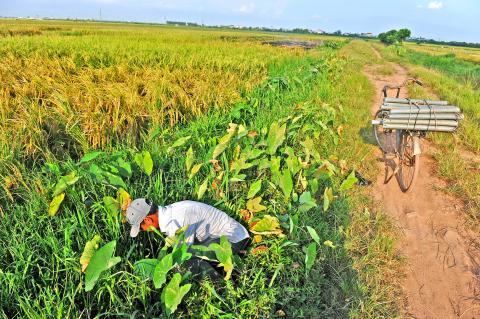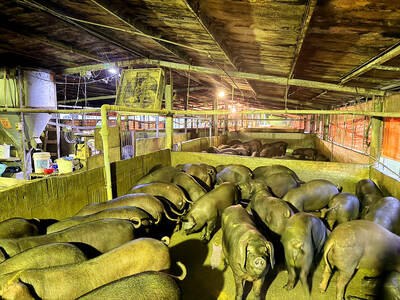Governments have agreed the first international standards limiting carcinogenic arsenic pollution in rice, a key move to protect consumers of what is a staple food for billions, the UN said.
The Codex Alimentarius Commission, the top global decision-making body for food standards, issued the decision at its annual meeting in Geneva.
“Arsenic is an environmental contaminant. It occurs naturally and is taken up by plants from the water and soil when they’re growing, in particular rice,” said World Health Organization food safety coordinator Angelika Tritscher.

Photo: AFP
照片:法新社
The commission set a maximum of 0.02 milligrammes of arsenic per kilo of polished race — the product that is traded and consumed.
Arsenic occurs in the Earth’s crust. Some of the heaviest concentrations are in Asia, where rice is a mainstay. A key problem is paddy fields irrigated with water pumped from shallow wells containing arsenic-rich sediments. Heavy rice consumption has been found to compound the impact of arsenic in drinking water.
Bangladesh has been a top concern, with tens of millions of rural dwellers exposed via wells drilled in the 1970s in “access-to-water” programmes. Parts of Cambodia, China, India and Vietnam have also been affected.
Long-term exposure can cause cancer and skin lesions, Tritscher said. It is also linked to heart disease, diabetes and damage to the nervous system and brain.
(AFP)
各國政府同意第一個限制稻米中砷污染致癌的國際標準,這是保障數十億以此為主食的消費者的關鍵行動,聯合國說。
全球食品標準最高決策機構「國際食品法典委員會」,在其日內瓦年會中發佈這項決定。
「砷是環境污染物。它自然存在,植物在生長時,從水與土壤中吸收它,特別是稻米。」世界衛生組織食品安全協調員崔徹爾說。
該委員會設定每公斤精白米,也就是拿來交易與消費的成品,砷含量以零點零二毫克為上限。
砷存在於地殼中。一些濃度最高的區域是稻米為主要作物的亞洲。從富含砷沈積物的淺井抽用水來灌溉稻田,是一個關鍵問題。已發現大量攝食稻米加重飲水中的砷污染衝擊。
孟加拉的情況最令人關切,因為數千萬農村住民透過一九七零年代「取得用水」計畫所鑽鑿的井,而暴露於砷污染。柬埔寨、中國、印度與越南部分地區也受影響。
長期暴露恐導致癌症與皮膚病變,崔徹爾說。這也和心臟病、糖尿病有關,並將損害神經系統與大腦。
(法新社/翻譯:魏國金)

A: Hey, the world’s major dictionaries just unveiled their words of the year for 2025. B: Yup, the Cambridge Dictionary chose the word “parasocial,” which refers to a connection that someone feels between themselves and a famous person they don’t really know. A: One-sided parasocial relationships with celebrities, influencers and even AI chatbots have clearly become more common. B: The Oxford Dictionary picked “rage bait” — online content designed to elicit anger by being frustrating, provocative or offensive in order to increase traffic to Web sites or social media accounts. A: The Collins Dictionary picked “vibe coding.” Let’s

A: Apart from the world’s major dictionaries, the online Dictionary.com actually picked “67” as its word of the year. B: What does “67” even mean? A: Even the dictionary wasn’t exactly sure about its meaning. The slang term’s origin might be traced to US rapper Skrilla’s song Doot Doot (67). Aren’t Taiwanese media outlets choosing the Mandarin word for 2025? B: Yeah and after hearing the song Good-for-Nothing, adapted from some catchphrases of Legislator Wang Shih-chien, I’m going to vote for the character “tsung” (hasty) from the lyrics. A: Hopefully, in the new year, we’ll be calm as the

Sea star wasting disease (SSWD) is a strange and serious illness affecting sea stars, or starfish. This disease causes sea stars to develop painful lesions, lose their arms, and eventually turn into a gooey, melted mess. Since it was first observed in 2013, millions of sea stars along the Pacific coast of North America have died from this __1__. Although viruses were once considered a possible cause, researchers now believe that environmental stressors and microorganisms are primarily __2__ for sea star wasting disease. One of the main environmental triggers appears to be warmer ocean water. When the water heats

For many people in Taiwan, childhood memories of rural life include pig pens standing beside family homes. Leftover rice, vegetable scraps and soup from daily meals were poured into buckets and fed to pigs. This practice of feeding pigs with household food waste was once a common way of life, both an economic choice and an expression of agricultural society’s deep respect for conserving resources. From a practical standpoint, pigs are omnivorous animals capable of efficiently digesting food scraps that humans can no longer eat. For rural households, food waste cost almost nothing, yet it could be converted into pork, a